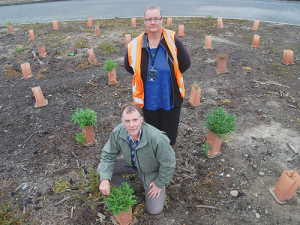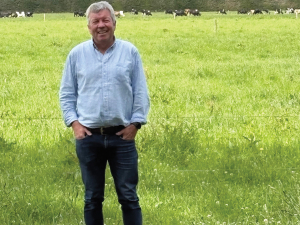Tai Tapu native plant nurseryman and consultant Stephen Brailsford is managing the replacement of exotic trees at Burnham Military Camp. The project, three years on, has seen up to 45,000 natives planted.
Sparked by wind storm damage in September 2013, the project is to replace most of the camp’s exotic trees with the kind of native bush originally standing on the Canterbury Plains’ dry soils.
Some 40 native species are being planted using, as far as possible, genetic material native to the Canterbury Plains and seedlings grown by several contract nurseries.
The scale of the project is easily seen from the public Aylesbury Road, between the main camp and its sports fields. Big swathes of the native plantings are visible as ranks of brown or blue plastic shelter tubes surrounding each plant.
Burnham has used exotics for decades, as windbreaks, training and exercise spaces, and visual screening from the public roads that run through the camp.
“Really it’s a safety thing because people tend to rubberneck and it causes this space to be quite dangerous,” New Zealand Defence Force South Island land management officer,” Shona Sam told Rural News.
She says after many pine trees fell in the 2013 storm the army assessed what was left, finding that those most likely to fall are pines and eucalypts, and Douglas fir a close third. But none of the camp’s “solid-rooted” oaks fell in the storm and they will remain, with some younger exotics.
“We did a lot of research and employed Stephen Brailsford, because we needed to find something which could establish without irrigation, could live here without much effort and, of course, we’re bringing in a bit more biodiversity and bringing the community into this space as well,” Sam explains.
“We trialled a patch and it was successful. We have about a 95% success rate with all the trees we planted. So, with Brailsford’s methodology it’s proven to work… and do well in this dry old river bed.”
Despite no irrigation through a succession of dry summers, the plots are thriving, with self-seeded natives already popping up in the older plantings.
Brailsford says it’s important to have the mix of proper forest canopy, sub canopy and understory plants.
“This is the plant community that would have naturally colonised these recent riverbed soils,” he explains.
“Because they are colonising plants they start to fruit and seed quite early in their life cycle and once you’ve got that going you’ve got all sorts of insects and birds that occupy the niches in this vegetation and consume that food. More complex organisms than plants need that habitat and shelter and that’s what we’re providing.”
Brailsford says similar plantings at the Lincoln University Dairy Farm are already attracting bellbirds and tui from Banks Peninsula, and he expects that at Burnham. Wax-eyes and common skinks have already colonised the Burnham plantings.
He says the 95% success figure is the minimum he would expect of the project “if you do things right”.
The key is his weed management system, he says.
“This is really dry land, some of the boniest, driest soils we’ve got in Canterbury -- Lismore stony silt loam. There’s not much moisture retention here. Any little bit of weed growth you have in here will really suck out the moisture.”
Each plant has a felted wool weed mat around the stalk and a surrounding plastic protection tube supported by light bamboo stakes.
Herbicides are used between the plants, applied about three or four times a year, rapidly reducing as the plants take hold.
The plastic tubes restrict the spray to the spaces between plants – no fear of hitting the plants themselves.
Brailsford admits his system was more expensive per plant to start with, but reckons it is ultimately cheaper and more successful. He has seen major projects with many thousands of plants planted, but very few surviving.
The Burnham plantings are expected to become self-supporting as natural regeneration takes over.

















